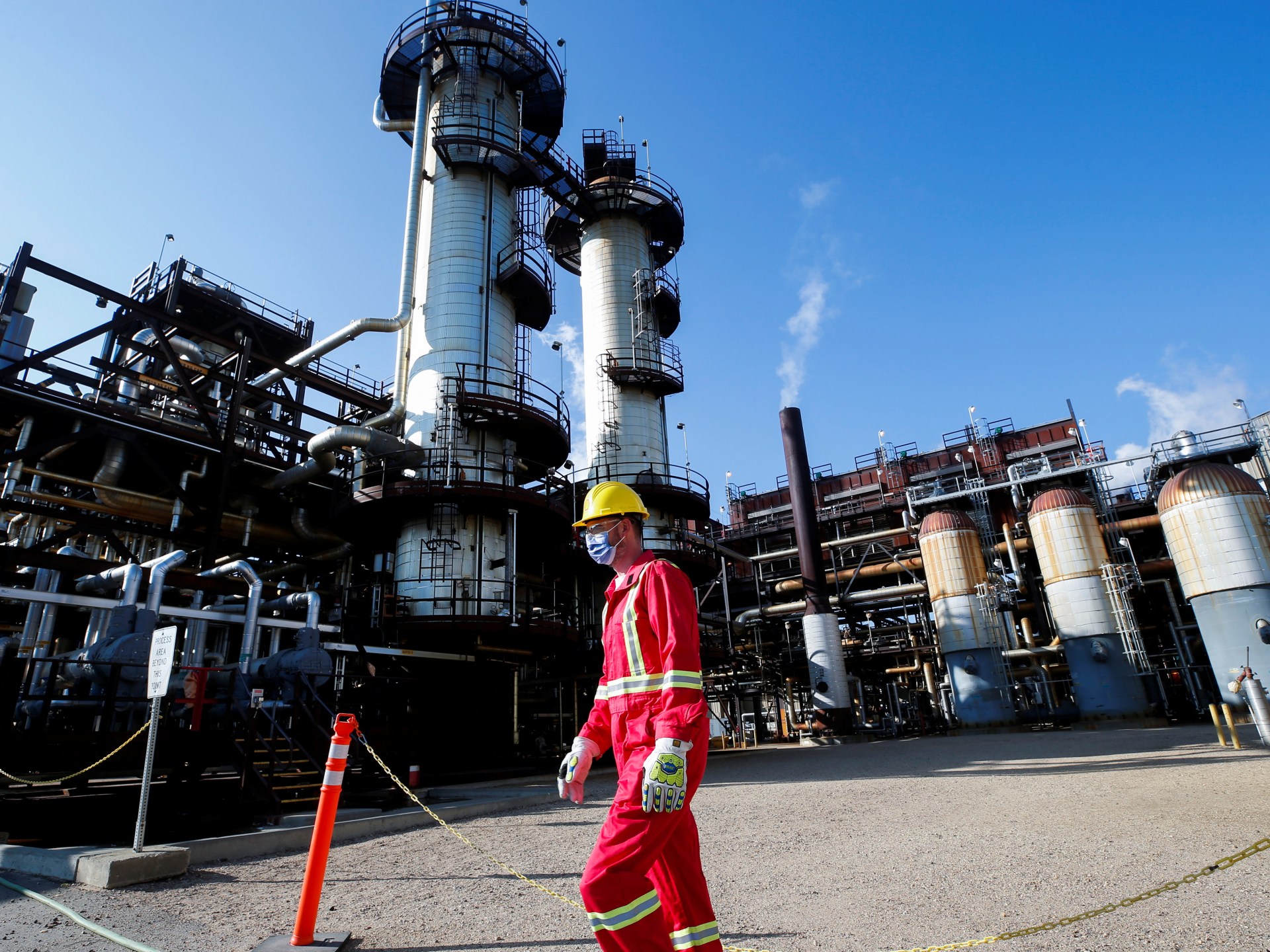Explainer: Carbon capture projects tackling climate change | Climate Crisis News
A groundbreaking offshore carbon capture and storage site will be launched in the Danish part of the North Sea on Wednesday.
Carbon dioxide captured in Belgium and transported by ship is to be injected into a depleted oil field 200km (120 miles) from the North Sea coast as part of what is called the Greensand project.
A consortium of companies centred around Germany’s Wintershall Dea and Britain’s INEOS are jointly working on Greensand.
According to Wintershall, the project is the world’s first cross-border offshore CO2 storage with the explicit purpose of mitigating climate change.
The International Energy Agency and United Nations climate scientists say carbon capture and storage (CCS) technology is a vital tool in meeting climate targets.
Below is a look at Greensand and other CCS projects under way throughout Europe:
NORTH SEA
NORWAY
Northern Lights, a joint venture project by Equinor, TotalEnergies and Shell. It plans to start injecting up to 1.5 million tonnes per annum (mtpa) of CO2 into saline acquifer near the Troll gas field from the middle of 2024. There are plans to increase storage capacity to 5-6 mtpa from 2026, pending demand.
Smeaheia, a project by Equinor to develop a storage site in the North Sea with a potential to inject up to 20 mtpa from 2027/2028. Equinor, which was awarded the exploration licence in 2022, said it is looking at injecting the CO2 captured from its own hydrogen production, as well as some industrial customers in Europe. The company aims to make the final investment decision in 2025.
Luna is a project led by German Wintershall Dea, to store up to 5 mtpa of CO2 at a site some 120km west of Bergen. Wintershall Dea and its Norwegian partner Cape Omega were awarded an exploration licence in October. Wintershall Dea has a 60 percent stake and Norway’s Cape Omega has the remaining 40 percent in the licence.
Errai is a joint project by Britain’s Neptune Energy and Norway’s Horisont Energi to develop a storage site in the North Sea with 4-8 mtpa capacity and a receiving terminal onshore. Germany’s E.ON plans to join the project if Norway approves the application for the licence to store CO2.
Trudvang is a joint project by Sval Energi, Storegga and Neptune Energy to develop a storage site east of the Sleipner gas field in the North Sea with a capacity to inject about 9 mtpa of CO2 from 2029. Sval is the proposed operator of Trudvang with a 40 percent ownership, while Storegga and Neptune each have 30 percent.
BRITAIN
Acorn CCS is a project off the coast of Scotland to develop a storage site with an annual capacity of 5-10 mtpa of CO2 by 2030. Storegga, Shell and Harbour Energy each hold 30 percent stakes and North Sea Midstream Partners (NSMP) the remaining 10 percent in the project.
Viking CCS, led by independent oil and gas firm Harbour Energy, aims to store up to 10 mtpa of CO2 by 2030 at the depleted Viking gas field in the southern North Sea. It plans to start injecting CO2 in 2027, initially at a rate of 2 mtpa of CO2, ramping up to 10 mtpa by 2030 and 15 mtpa by 2035. RWE, Phillips 66, VPI and West Burton Energy are looking at storing CO2 emissions at the Viking site.
Northern Endurance, a BP-led partnership, aims to develop infrastructure to transport and store about 20 mtpa of CO2 under the seabed in the southern North Sea from 2030. The project, which also includes National Grid, Equinor, Shell and TotalEnergies, aims to store CO2 emissions captured at at industrial clusters in Teesside and Humberside.
THE NETHERLANDS
Porthos, a project by the port of Rotterdam, Gasunie and EBN, aims to store 2.5 mtpa of CO2 in depleted Dutch gas fields in the North Sea. All storage capacity has been already contracted by four industrial partners: Air Liquide, Air Products, ExxonMobil and Shell. The project planned to start CO2 injections in 2024-2025, but the startup is now delayed until 2026 because of a legal dispute.
L10, a project led by Neptune Energy, to store 4-5 mtpa of CO2 in depleted gas fields in the Dutch North Sea. Other partners in the project are ExxonMobil, Rosewood Exploration and state-owned EBN. The partners plan to submit a storage licence application in March with first CO2 injections seen in 2027-2028, later than previously planned in 2026.

DENMARK
Greensand is a pilot project led by INEOS Energy and Wintershall Dea to demonstrate that CO2 can be stored underground in the Danish part of the North Sea. The project aims to inject initially up to 1.5 mtpa of CO2 from 2025-2026, increasing capacity to 8 mtpa by 2030.
Bifrost, a project led by TotalEnergies, aims to inject up to 3 mtpa of CO2 into depleted Harald gas fields in the Danish North Sea from 2027, and aims to increase capacity to more than 10 mtpa by 2030. The project also involves Orsted, which operates offshore pipelines, and the Technical University of Denmark. In February, Denmark awarded TotalEnergies two CO2 storage licences including the Harald area.
GERMANY
Wilhelmshaven CO2 export terminal is a project led by Wintershall Dea to build a CO2 liquefaction and temporary storage facility at Wilhelmshaven, Germany’s only deep-water port, and then the CO2 could be shipped or piped to permanent storage sites under the North Sea. It aims to initially handle about 1 mtpa of CO2 from 2026.
OTHER STORAGE POINTS
BRITAIN
The HyNet North West project aims to convert gas and fuel gas from the Stanlow refinery in Cheshire into low-carbon hydrogen, capturing and transferring the CO2 produced during the process by pipelines to offshore storage in Liverpool Bay. Pre-existing salt caverns in Cheshire will also be used as storage. Operations are expected to start in 2025 and will store about 4.5 mtpa of CO2, rising to 10 mtpa by 2030.
BULGARIA
ANRAV, a project led by private Irish energy company Petroceltic, will link CO2 capture facilities at HeidelbergCement’s Devnya Cement plant in northeastern Bulgaria with offshore permanent storage in the depleted Black Sea gas field of Galata. Expected to start operations in 2028, it will have a capacity of 800,000 tonnes of CO2 per year.
FRANCE
PYCASSO is a project capturing carbon from industries in the southwest of France and in the north of Spain and storing it in a depleted gas field in Aquitaine. The project is planned to transport about 1 mtpa of CO2 by 2030.
ICELAND
The Coda Terminal will be a cross-border carbon transport and storage hub in Straumsvík, operated by Icelandic carbon storage firm Carbfix. CO2 captured from industrial firms will be shipped to the terminal to be dissolved in water before being injected into basalt bedrock. The operations, scaled up in steps, are set to reach up to 3 mtpa of CO2 from 2031.
The Silverstone project, coordinated by Carbfix, will deploy commercial-scale CO2 capture, dissolve CO2 in water and inject it into underground basalt rock for mineral storage into the Hellisheidi geothermal power plant near Mount Hengill. Silverstone will capture and store about 25,000 tonnes of CO2 a year. It is expected to start in the first quarter of 2025.
ITALY
CCS Ravenna Hub, led by energy company ENI, is a project to capture CO2 and transport it to offshore depleted gas reservoirs off the coast of Ravenna in the Adriatic Sea. The first phase of the project is scheduled in 2023. The full capture, transport and storage chain will handle up to 100,000 mtpa of CO2.
IRELAND
The Cork CCS project aims to store carbon captured from Irish industrial facilities in a depleted gas field in the Celtic Sea, potentially reusing an existing pipeline for transport. The project is led by utility Ervia.
SWEDEN
Slite CCS is a CCS project led by HeidelbergCement and its Swedish subsidiary Cementa, at its Slite cement plant on the Swedish island of Gotland in the Baltic Sea. It aims to capture up to 1.8 mtpa of CO2, about 3 percent of the country’s total emissions, and store those at several sites under development in the North Sea.





Pingback: 토렌트 사이트
Pingback: ที่พักรายวัน แถวรามอินทรา
Pingback: our website